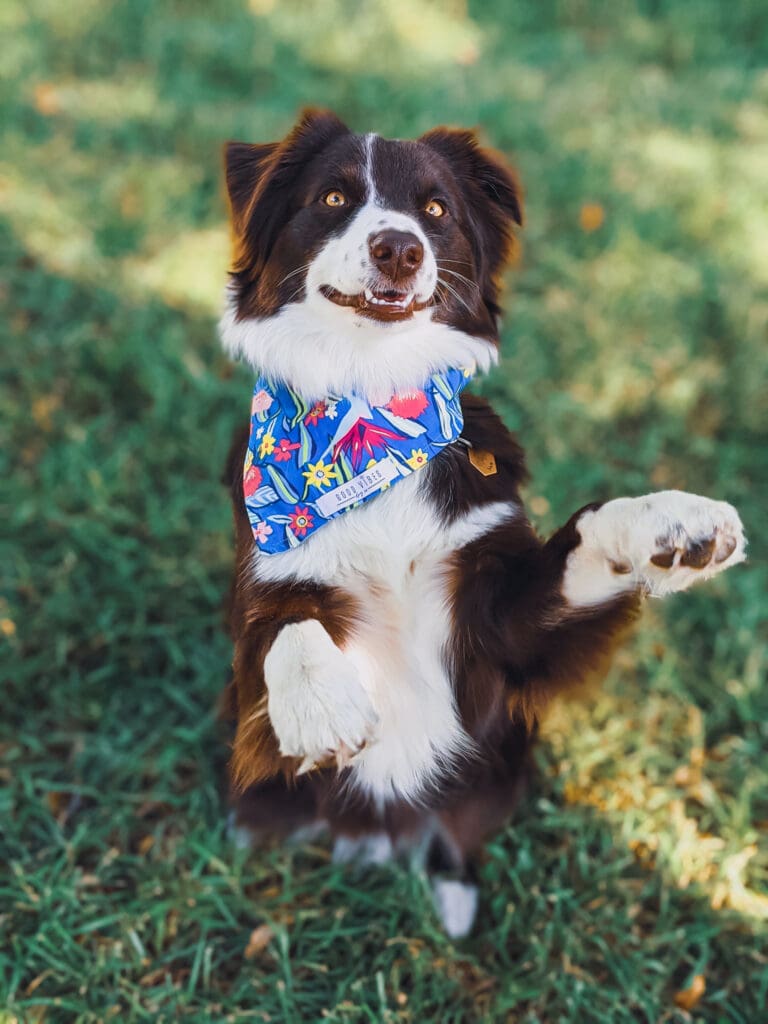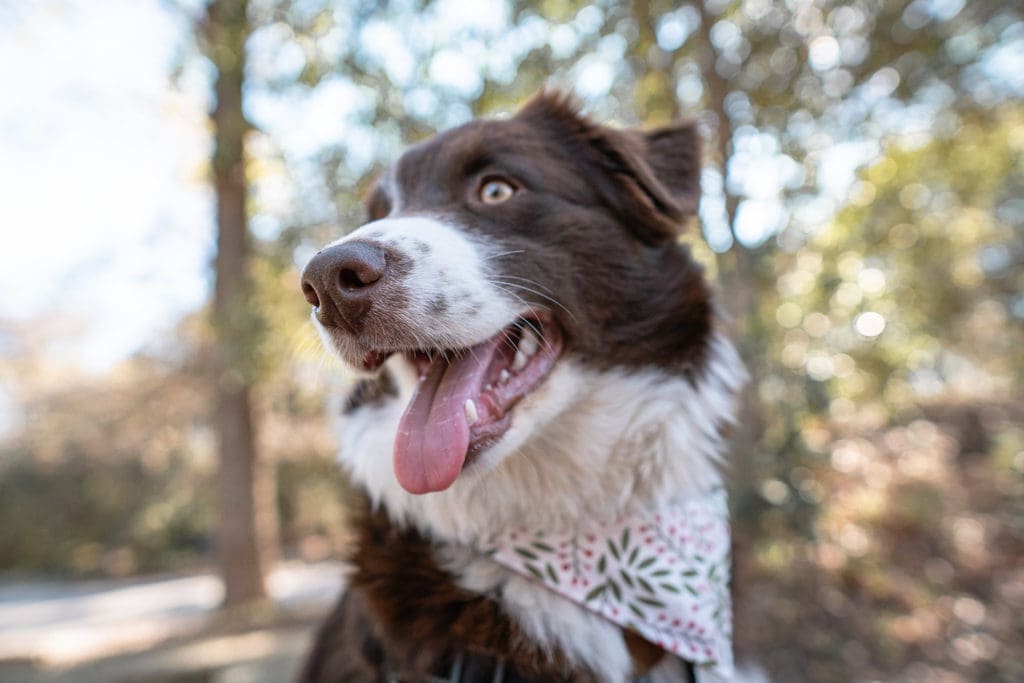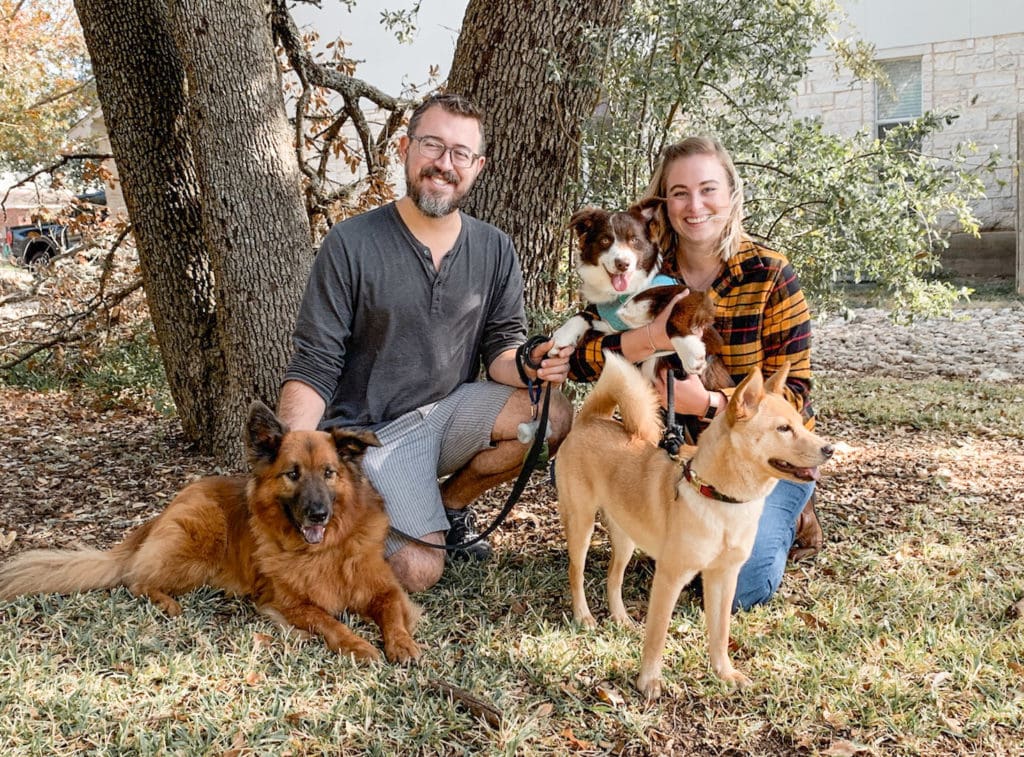Have y’all met Margot yet? If you follow us on Instagram (@thedinkdogmom), you definitely have! Margot is a 6-month Australian Shepherd puppy we adopted from a breed specific rescue at the beginning of December. Breed specific rescues are rescue organizations dedicated to a particular breed of dog, like Australian Shepherds.
Due to the prevalence of irresponsible breeding, it is estimated that around 5% of dogs in shelters are purebred. Although this number is much smaller than than the 25-30% statististic of the 90s, it is still notable considering around 3.1 million dogs enter American shelters each year. Part of this decrease may be attributed to the work of breed specific rescues, many of which help people responsibly rehome their purebred dog before surrending it to an animal shelter. Additionally, many of these dog breed rescue groups take on dogs that are mixed with (or appear to be mixed with) the dog breed they are focused on.
There are pros and cons of adopting from breed specific rescue groups. A good breed specific rescue will parallel an ethical breeder: they will have a strong understanding of the breed and the breed’s specific quirks and needs, as well as the type of home the breed would do well in. They will also likely have a system in place to try and prevent a dog from ending up in the shelter again, which usually looks like a rigorous application process and a lifetime relationship.
That said, not all rescues are created equal, and there are certainly groups cashing in on breed popularity. There are several red flags to look out for when choosing a rescue to support, including rescues that charge exceedingly high adoption fees and rescues that focus on dogs of a certain look (such as prioritizing merle Aussies over non-merle Aussies in their intake).
Adopting from a breed specific rescue is not always simple or straightforward, so I wanted to shed a little bit of light around the whole process, especially after having gone through it myself!
Why Adopt from a Breed Specific Rescue vs Purchase From An Ethical Dog Breeder
This is a great question that does not have a black-and-white answer. The simplest answer is that both breed specific rescues and ethical breeders have their place in a system working to improve the welfare of dogs and dog breeds. Choosing one or the other boils down to your needs, preferences, and lifestyle.
If you want a certain breed of dog for a specific purpose– sports, conformation, or even predictability of temperament– then finding an ethical breeder who is producing dogs that align with your goals is your best bet. This can be especially important if you don’t have the capacity to handle genetic illnesses or behavioral challenges like anxiety, reactivity, etc. That isn’t to say that well bred dogs never have a genetic issue or a behavioral problem, but a dog from a good quality breeder will have the cards stacked in its favor. Plus, ethical breeders give their puppies the best start in life, which means not only are you getting a genetically sound dog, but you are getting a genetically sound dog that has been nurtured into being the best version of itself. This makes a dog from a quality breeder more predictable.
However, there are some challenges to shopping a good quality breeder. They might not have any upcoming litters that suit your needs, which means you would need to wait a long time for a puppy. Or, they might be out of your price range. Moreover, not everyone requires the predictability that comes from purchasing a well bred puppy, and opening your home to a rescue is a really wonderful choice. If you are simply looking for a companion animal, then adopting from a breed specific rescue is a great alternative! Certainly it is better than supporting a backyard breeder!
I would recommend adopting from a breed specific rescue if you:
- Are passionate about the breed and want to help dogs who are victims of backyard breeding.
- Are willing and able to handle behavioral challenges and temperament issues.
- Are looking for a companion pet.
Why Do Breed Specific Rescues Exist?
In a nutshell, breed specific rescues exist to clean up the mess left by backyard breeders. A backyard breeder is ANY breeder who breeds for fun or money. Good breeders breed with a purpose: to better the breed and/or to create a certain version of a breed. They don’t breed dogs because they are cute, because they love puppies, or because they can make a lot of money.
Because backyard breeders are not selective about the dogs they breed, they often produce unpredictable dogs, both temperament-wise and health-wise. Moreover, they are willing to sell a puppy to just about anyone who will pay the right price. This combination leads to people purchasing a dog they are not prepared to care for under the best of circumstances, let alone a dog that has behavioral or health challenges due to poor breeding. And, because a backyard breeder rarely takes a dog back, these dogs end up in the shelter when a person can’t take it anymore.
That’s where the breed specific rescue comes into play. Because they focus on a single breed, they specialize in all the quirks that come with it, from common behavior issues to genetic health problems. They are also better equipped to find the right home for a specific dog breed.
Finally, breed specific rescues also help with responsibly rehoming dogs. These could be dogs from backyard breeders that the rescue wants to keep out of the already over-burdened shelter system, OR the rescue could work in cooperation with a quality breeder to help find a new home for a dog whose family can’t keep it for any reason.
Pros and Cons of Adopting from a Breed Specific Rescue


Adopting from a breed specific rescue can be difficult, frustrating, and somewhat of a long process. You might be able to walk into a city shelter and leave with your best friend that same day. It’s not the same with a rescue group. Not only do these organizations not have brick-and-mortar locations, but they also review potential adopters with a fine-toothed comb to ensure their dogs end up in the right home.
Anyone who has worked or volunteered in animal rescue knows how difficult it can be assessing a prospective adopter. Even people with the best intentions don’t always have the follow through to be a responsible dog owner. How can you determine how a dog will be treated for the next 10+ years? How much time and money will a person be willing to spend on training? Will the dog be appropriately exercised? Socialized? Fulfilled?
It’s a tough challenge to navigate for sure. This is why there are so many hoops adopters have to jump through when adopting from a quality rescue group: references, vet history, background checks, home visits, and so on. All of this is to ensure the long-term health and happiness of the dog. As you can imagine, rescues pour a lot of time, money, and love into the dogs they rescue, and they never want them to end up in a bad situation again.
Challenges Of Adopting from Breed Rescues
Frustratingly, this sometimes leads to great adopters getting disqualified. One way to look at the situation is this: would you rather disqualify a good adopter, or send a dog to a bad home where they could end up abused, neglected, or abandoned? There is so much nuance to this situation, and I am not trying to say that these processes are perfect or that rescues are “right” in implementing them. In fact, I’m not convinced there is a straightforward “right” answer here. What I am saying is that when an ethical rescue rejects an application, it is understandable.
One way to ensure your application is accepted by a purebred dog rescue is to be ready to communicate and answer any and all questions. This is why doing your research is such a crucial first step (more on this later)! For example, when we applied to adopt Margot, our vet did not have a clear record that our previous dogs had been on consistent heartworm prevention (a requirement for this particular rescue). This is because our previous dogs were in the same weight class for awhile, and we had purchased heartworm prevention under one dog’s name and not the other. I had to sleuth through my 1800PetMeds shopping history to track down all of our purchases, combine that with our vet records, and “prove” that our dogs were always on preventatives.
Was that annoying? Yes. Did I understand? Also a yes! Heartworm prevention is a crucial part of dog wellness, especially here in Texas! I had never considered that on paper we did not have a clear record of heartworm preventatives. But, for a rescue that does not know you, it is what is on paper that counts. They rely on paper trails, character references, and vet verifications to ensure you will provide a loving, longterm home for one of their dogs.
Perks of Adopting from Breed Rescues
All of that said, there are several perks to adopting from ethical purebred dog rescues. For one, it’s much easier to identify a dog that will be a great fit for your home and lifestyle, which is a huge help with adopting a rescue dog and offers back some of the predictability you can get from shopping an ethical breeder.
Need a dog that is good with kids? A breed specific rescue will find that for you. Need a dog that won’t eat your cat? A breed specific rescue will find that for you. Obviously there are some constraints here, but for the most part, a good rescue will priortize matching you with a dog that fits your needs, just like a good breeder would do.
This is possible because breed specific rescues rely on foster homes to pull dogs out of shelters and off the streets. Foster homes come to know their foster dogs really well. They know their energy levels, their social skills, and their behavioral issues. Plus, fosters often work on training while the dog is in their care. This means that many rescue dogs in foster homes are better potty trained, crate trained, and sometimes even have basic manners down.
Additionally, because the dogs live in foster care rather than a crowded shelter or kennel, they are also likely to be less stressed and in better health. Any dog you adopt from a breed specific rescue will come vaccinated; spayed and neutered; free from parasites like fleas, ticks, and worms; and with a clean bill of health (as far as a vet visit can confirm, of course). Many rescues require dogs to be in their care for 3-4 weeks at a minimum to give them time to decompress and to ensure they are not carrying any unexpected diseases.
Finally, many of these breed specific rescue groups offer a really tight-knit community of support. Similar to a great breeder, a great breed specific rescue has the knowledge to support and guide their adopters. They can help you with anything from grooming recommendations to behavior issues.
What to Expect when Adopting from a Breed Specific Rescue
After going through the process of adopting from a breed specific rescue myself, I wanted to share a little bit about the process, what to expect, and what to look out for. Adopting from a breed specific rescue– or any rescue, really– is a very different experience than adopting straight from a shelter. It can be frustrating for someone who doesn’t understand the rescue’s side of things, which often leads to people heading straight for a backyard breeder.
A good rescue group is not in it for the money. They are usually volunteer-run nonprofits who rely on donations and foster homes to rescue and care for dogs. Adoption fees are used to cover the cost of care for dogs, including the standard stuff like a physical exam, spay/neuter surgery, and microchipping, as well as more intensive care for dogs who are sick or injured.
These rescue groups pour their heart and soul into the dogs they save, and they often see the absolute worst side of people. I’m talking about the people who buy a German Shepherd and then dump it at a shelter because it got too big; the people who adopt a cute puppy and then return it because it peed on the floor.
Choosing the Right Breed: Do Your Research Before Looking at Adoptable Dogs
Bringing home a dog is a big responsibility, so it’s important to do your research. There are so many questions you should ask yourself when you want to get a dog:
- What is your housing situation? If you rent, does your landlord allow dogs? What will happen if you move? Are you willing to commit to finding dog-friendly housing for the next 10-15 years?
- If you don’t have a fenced yard, are you prepared to take your dog for frequent walks for potty breaks? What is your plan for exercising and enriching a dog’s life?
- Does your work schedule accomodate caring for a dog? What will happen when you go out of town?
- Are you willing to put in the time and energy to train a dog, and are you prepared to deal with behavioral problems?
- What circumstances or situations would lead you to give a dog up?
It’s also helpful to make a list of criteria you want or need in a dog and then use that list to guide your adoption. For example, you want to avoid a vocal dog because you live in an apartment, or you need a cat-friendly dog because you already have a cat. What energy level are you looking for, and things like that.
Also, be sure to research the breed you are interested in to make sure it aligns with your list of criteria. It doesn’t matter how beautiful or adorable a dog is; if it doesn’t fit your lifestyle, you both are going to be miserable. Being honest with yourself will save you a lot of heartache and trouble later down the road. Plus, one of the first things an ethical breed specific rescue will ask is if you have experience with or knowledge about that breed.


Applications, References, Interviews, and Home Visits
Adopting from a breed specific rescue is not like adopting from your local shelter. Their adoption process and adoption contracts are typically much more strict than those of a city shelter, because they are trying to filter applicants and ensure their dogs go to a safe and well-matched home. In fact, a rescue group willing to adopt out to any individual willing to pay an adoption fee should be a red flag. You want a rescue group to have a clearly outlined application process that includes things like:
- A thorough application that includes questions about your plans to care for the dog.
- An interview, either over the phone or via Zoom or even in person, to get to know you better and learn more about what sort of dog you are looking for.
- Photos of your home and/or a home visit
- An in-person meet and greet for you to meet the dog and talk to the fosters, who are instrumental in matching the dog with the right family.
Although this might seem really invasive, each step has a distinct purpose. An application provides a starting point and record of people interested in adoptiong, and an interview is an opportunity for both rescue and adopter to learn more about each other. Photos of your home and/or a home visit is one way rescues can rule out people who may not be fit for adopting a dog (like an animal hoarder, for example).
It doesn’t matter if you live in an apartment or a house, if you have a yard or not; an ethical rescue will look for things that help determine what type of dog will be the best fit. If you do have a yard, is the fence secure? How high is it? How much space do you have both indoors and outdoors? These types of questions aren’t mean to be discriminatory (although many rescues do struggle with discrimination, both implicit and explicit). Rather, these measures are meant to help the rescue match you with the right dog. For example, a short fence may not be an issue for some dogs, but other dogs may be prone to fence-jumping.
Lastly, the in-person meet and greet is the last step to ensuring a good match. Not only is this the opportunity for you, as an adopter, to decide if the dog is right for you, but the foster can also provide insight into a dog’s personality, quirks, and challenges.
Ultimately, a foster may decide you aren’t the perfect home for a dog, and that can be really heartbreaking. But, it’s important to remember that these decisions are based on the welfare of the dog first, as well as ensuring your needs and wants are respected!


Finding a Breed Specific Rescue And Submitting an Application
The first step of finding a breed specific rescue is to just google it. In the United States, most of these rescues adopt statewide or even region-wide, depending on their network of volunteers. Find a breed specific rescue near you, and check out their website or social media pages. It is common for rescues to not have the best digital presence, so don’t be afraid to reach out via email, too, to ask some questions.
Things you want to look out for are:
- A solid, clearly communicated application process.
- Set pricing that does not vary by color or appearance (though it may vary by age)
- Descriptions of available dogs with requirements clearly outlined (IE no other dogs in the home, no children, medical care required, etc).
If you feel like the rescue is a good fit, then it’s time to submit an application, even if they don’t have a specific dog that you want. It’s helpful to get on a rescue’s radar and let them know what you are looking for, that way when the right dog comes along, they already have your application on file.
Step One: Fill out an Application
The first step to adopting from a breed specific rescue is to fill out an adoption application. Again, it does not matter if they have a dog listed that you want or not. Filling out an application indicates you are serious about adopting. There are tons of people who are quick to comment on a social post about wanting to adopt a dog, but they never actually follow through. So, if you want the rescue to take you seriously, fill out an application!
These applications can be lengthy, so be prepared to answer all of the questions carefully and honestly. In particular, be clear and upfront about your lifestyle (active vs couch potato) and what personality/temperament you want (dog social, people social, quiet, etc). If you have any questions up front, you can always reach out to the rescue directly via email or social media.
Keep in mind, you can definitely apply to more than one rescue. Most breed specific rescues are fairly small and can only take in a limited amount of dogs. When Brady and I were looking for a third dog, we had applied to four different breed specific rescues!
Step Two: Communicate, Communicate, Communicate!
Communication is key to finding the perfect match! If there is a specific pup you are interested in, definitely let the rescue know. However, if you don’t see a specific dog that catches your interest, let the rescue know what you are looking for (go back to that list of criteria you created earlier!).
I also recommend surfing the rescue’s social media pages. Many dog rescue groups update their social media pages (Facebook in particular) much more frequently than their websites. For us, it was easier to find available dogs, adoption events, and even ask questions via DM.
If you do find an available pup you are interested in after you’ve filled out an application, send a DM or email to the rescue and let them know you have an application on file and are interested in X dog. Remember though, a good match is about personality, not looks. Just because a puppy is super cute online does not mean they will be a good fit for your lifestyle.
Step Three: Let the Rescue Do Their Thing
Have patience. Remember, rescues are almost always 100% volunteer run. These volunteers likely have full-time jobs, families, and pets of their own in addition to their rescue work. Sometimes it takes a little time for your application to get processed and your questions answered.
Most importantly, do not be disheartened if a dog you adored on their website or Facebook page ends up already adopted. What you don’t see behind the scenes of rescue work is a team of dedicated volunteers reviewing applications and matching dogs to the perfect home.
Sometimes, a dog is matched before its photo is ever shared publicly! This means that if your application is approved, the rescue may contact you about available dogs that meet your criteria, some of whom might not even be advertised on their website or social media pages.
Trust the rescue to do its job in finding the perfect pup for your home, and don’t take it personally if you aren’t approved for the first dog whose photo you fall in love with.
What Breed Specific Rescues Wished You Knew
We adopted Margot from Lone Star Aussie Rescue, and I asked one of the rescue’s founders, Natalie, what she wished folks knew when adopting from a breed specific rescue. Here is her response, which really nicely summarizes what this post is all about:
- Do your research! Don’t run out and get any dog based on looks alone, or because you see they are super smart, pretty, etc. Most breeds have very specific traits/characteristics that don’t do well in all homes. Some require more attention, exercise, and mental stimulation than others.
- Just because you’ve adopted, don’t stop getting them out in the world! Many new owners think the dogs are great, and then keep them at home. Socialization with other people and dogs is important for all dogs throughout their lives. This prevents them from becoming overly protective or scared around other people and dogs.
- All dogs take some amount of time to settle in and start acting themselves. This varies from dog to dog, but know that they have to acclimate to their new family and environment just as people do when dropped into a new environment.
- Be extra cautious when you first bring them home. Your new dog has not fully bonded to you yet, which makes them a flight risk. Don’t leave doggie doors open or trust that they will be okay unsupervised in the backyard. Don’t assume they’ll be okay outside of a crate for hours on end without testing it out in shorter increments first.
- Smaller doesn’t mean easier/less energy. So many people are looking to adopt Mini Aussies (aka Miniature American Shepherds) because they think they are more manageable. The minis require just as much, if not more, exercise, mental stimulation, socialization, and training as standard Aussies.








3 Responses
I liked how you mentioned that you should look online to find breed-specific rescue in your area. My wife is wanting to find a breeder for the dog we want and we were wondering what we should look for in a reliable breeder. I’ll tell her that we should look for a breed-specific rescue in the area.